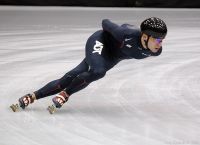Chest In to Corner
By Susan Ellis, February 2007

As discussed in the tip on the corner lay in, the entry lean can make or break a corner. It is the difference between accelerating in to a corner or simply drifting in. I would suggest reading The Corner Lay In – December 2004 before processing to find out more on how the corner lay in works and some tips to learning how to effectively lean in to it.
In watching the Koreans lay in to their corners during the 2006 Olympic Games I noticed they were doing something very different than the rest of the world. Not only did they have great compression in the belly to thigh (hip) angle, they were also putting their upper bodies further in to the turn than anyone. This gave them the ability to not only bring the weight forward to the ball much easier, but also improved their turning ability.
Click here to watch a video of bringing the chest in. Watch the skater in 3rd place.
This bringing the chest in happens off the right leg as you are laying in. There is a slight rotation inward around the ankle joint and the upper body comes across the left thigh so that the left side of the lower rib cage is inside your thigh rather than in line with your thigh.
It is imperative to bring your hips in and across at the same time as your upper body comes in, otherwise your butt cheeks will be left behind (OUT BUTT) and all you will have done is rotate your upper body in to the turn. Your chest and hips come across as one unit to accelerate you in to the turn.
Take your time to feel this part of the lay in and feel the carve of your right skate as it turns in to the turn. Don’t be in a rush to get your left skate back down as this takes away from the amount of lay in you can get. Likewise, don’t be in a rush to push with your right as this takes away from the time you can turn and ride your right skate to build pressure in to the ice.
Watch the video again.
In watching the Koreans lay in to their corners during the 2006 Olympic Games I noticed they were doing something very different than the rest of the world. Not only did they have great compression in the belly to thigh (hip) angle, they were also putting their upper bodies further in to the turn than anyone. This gave them the ability to not only bring the weight forward to the ball much easier, but also improved their turning ability.
Click here to watch a video of bringing the chest in. Watch the skater in 3rd place.
This bringing the chest in happens off the right leg as you are laying in. There is a slight rotation inward around the ankle joint and the upper body comes across the left thigh so that the left side of the lower rib cage is inside your thigh rather than in line with your thigh.
It is imperative to bring your hips in and across at the same time as your upper body comes in, otherwise your butt cheeks will be left behind (OUT BUTT) and all you will have done is rotate your upper body in to the turn. Your chest and hips come across as one unit to accelerate you in to the turn.
Take your time to feel this part of the lay in and feel the carve of your right skate as it turns in to the turn. Don’t be in a rush to get your left skate back down as this takes away from the amount of lay in you can get. Likewise, don’t be in a rush to push with your right as this takes away from the time you can turn and ride your right skate to build pressure in to the ice.
Watch the video again.
